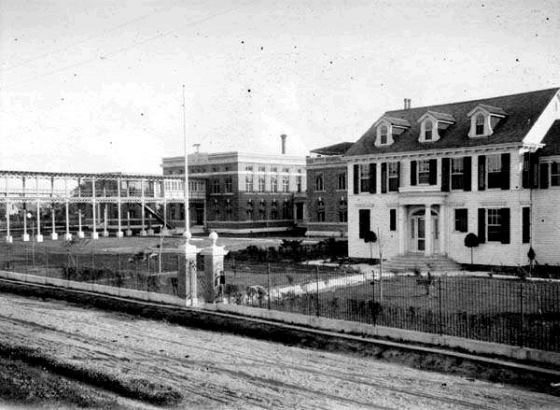|
Today in New Orleans History |
|
|
May 2


 The
U S Border Patrol New Orleans Sector Headquarters now sits on the site of the old U S Quarantine Station, the sister facility
to the long-since demolished U.S. Immigration Station in Algiers.  

To receive an update for each day in New Orleans
history, join our facebook page
- Today in New Orleans History
Marc Haydel Morial (born January 3, 1958) is the current president of the National Urban League. Morial
served as mayor of New Orleans from May 2, 1994 to May 6, 2002. He is married to Michelle Miller, an
award winning CBS News Correspondent. Marc Morial grew up in the Seventh Ward and is the son of New
Orleans' first African-American mayor, Ernest N. "Dutch" Morial, and teacher Sybil (Haydel) Morial. He is the second
of five children. Morial graduated from Jesuit High School in 1976, then received a bachelor's degree in economics at the
University of Pennsylvania in Philadelphia in 1980. Morial joined Alpha Phi Alpha fraternity. Morial then earned a Juris Doctor
degree in 1983 from Georgetown University in Washington, D.C. Morial opened a private law practice in New Orleans. He also
served as a board member for the Louisiana American Civil Liberties Union from 1986 to 1988. After an unsuccessful run for
Congress in 1990, in which he came in second place and was defeated in a runoff by Bill Jefferson, Morial ran for the Louisiana
State Senate in 1992. He won and served until 1994. He ran for mayor of New Orleans in 1994 and followed his father by being
elected. He ran again in 1998 and was re-elected. One of his opponents in the 1994 mayoral election was Mitch Landrieu, also
the son of a former mayor. Landrieu was elected Mayor of New Orleans in 2010. (WIKI)
Maurice Edwin "Moon" Landrieu, born in Uptown New Orleans on July 23, 1930) became the 56th
Mayor of New Orleans on May 2, 1970 and served as mayor until May 1, 1978. He also is a former judge.
He represented New Orleans' Twelfth Ward in the Louisiana House of Representatives from 1960 to 1966, served on the New Orleans
City Council as a member at-large from 1966 to 1970 and was the United States Secretary of Housing and Urban Development under
U.S. President Jimmy Carter from 1979–1981. He is the son of Joseph G. Landrieu (owner of a small corner grocery) and
Loretta (née Bechtel). Joseph G. Landrieu's grandparents, Geoffroy Stanislas Landrieu and Melanie LeMoine, had emigrated
to New Orleans from France in 1848. Maurice acquired the nickname "Moon" in his early childhood and later had
his name legally changed. He went to Jesuit High School. A promising athlete, Landrieu won a baseball scholarship at Loyola
University New Orleans, where he received a Bachelor of Arts in business administration in 1952 and a law degree in 1954.
As an undergraduate, he was elected student body president at Loyola. After a three year stint in the United States Army,
Landrieu opened a law practice and taught accounting at Loyola. In 1954, Landrieu married Verna Satterlee, with whom he had
nine children -- Mary, Mark, Melanie, Michelle, Mitchell, Madeleine, Martin, Melinda, and Maurice Jr. (WIKI)
Photo of the the Market Theater, located on Teche Street near Foto's Market, which provided Algerines with silent movies and vaudeville acts. The theater's farewell performances took place on November
14, 1915. The next day, the owner, Philip Foto, opened a new movie house, Foto's Folly Theater which was later affiliated
with United Theaters, Inc. Foto, a New Orleans native, also managed Panama Ice Company. He resided at 1801 North Broad, where
he died on Wednesday, May 2, 1956 at the age of 85. He was buried in Metairie Cemetery.
A resolution of the Third Municipality Council passed on April 20,1837 set the size of the municipality's
Guard at forty-five men and seven officers, including a captain, three chiefs of post, and three assistant chiefs. This force
was divided among a main post, a post in the Third District, and one in the Fourth District, extending to the shores of Lake
Pontchartrain. On April 13, 1840 the Council reduced the number of men to fifteen while keeping the same number of officers.
That legislation also eliminated a portion of the Guard that had been mounted. The lamplighters of the municipality apparently
also served Guard time until a resolution of August 13, 1840 decreased their numbers and exempted them from such duty. On
September 13, 1841 the Council abolished the Commissaries of Police for the Second District and ordered the Guard to assume
their responsibilities.On May 2, 1842 the Council resolved that Guard members had to be citizens of the U.S.,
speakers of English and French, and residents of the municipality. They were to be recommended by at least two other citizens
as "honest, sober, and industrious" persons. They were also required to give a security bond to the Recorder to
guarantee the faithful execution of their duties. (NOPL) |
|
|

To receive an update for each day in New Orleans history,
join our facebook page - Today in New
Orleans History.
Analytics |


